Rich in probiotics, the Gut Shot is a fermented vegetable drink that supports gut health by creating diversity in the microbiome-an easy step-by-step guide using veggies you already have with just 15 minutes of hands-on time. Video in Recipe Card!
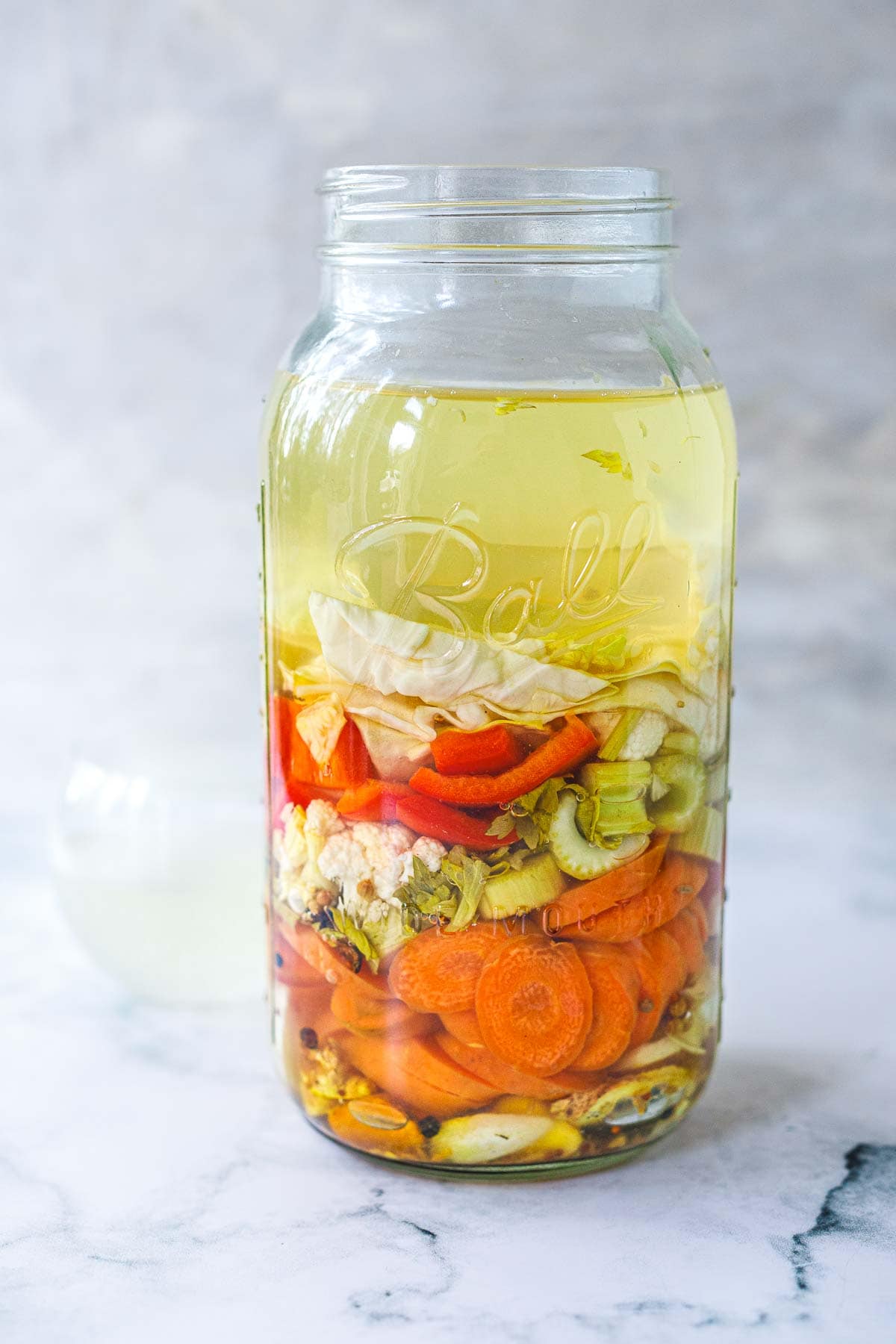
Introducing the Gut Shot! Tangy, flavorful and incredibly delicious, it is one of the easiest ways to increase diversity in our gut microbiome and support healthy digestion! Even a tablespoon a day is enough to flood your microbiome with gut-supporting probiotics, and it really doesn’t get easier than this! If you’ve made our sauerkraut or kimchi recipe, you’ll love this!
What I love about this easy recipe is how you can use veggies you already have on hand that need to be used up. A gut shot is different from kombucha or water kefir in that it is savory, not sweet, with no added sugar. And with no dairy, it is vegan and of course, gluten-free. With just 15 minutes of hands-on time, you’ll have a healthy, potent, gut-healthy brew with very little cost or effort in 3-5 days. Mother Nature is incredible!
Why You’ll Love This
- Incredibly nutritious! Full of raw fermented plant foods that provide healthy probiotics to support gut health and boost immunity!
- Use up extra veggies. A convenient way to use up leftover vegetables!
- Quick and easy. Only 15 minutes of hands-on time.
What Does a Gut Shot Taste Like?
Unlike kombucha or kefir, the gut shot is savory and made from vegetables. It is not sweet and has no added sugar. The flavor is tangy, pleasantly salty, almost like pickle brine, only even better! The longer you ferment it, the tangier it will taste. For optimal taste, ferment for 5 days.
Gut Shot Ingredients
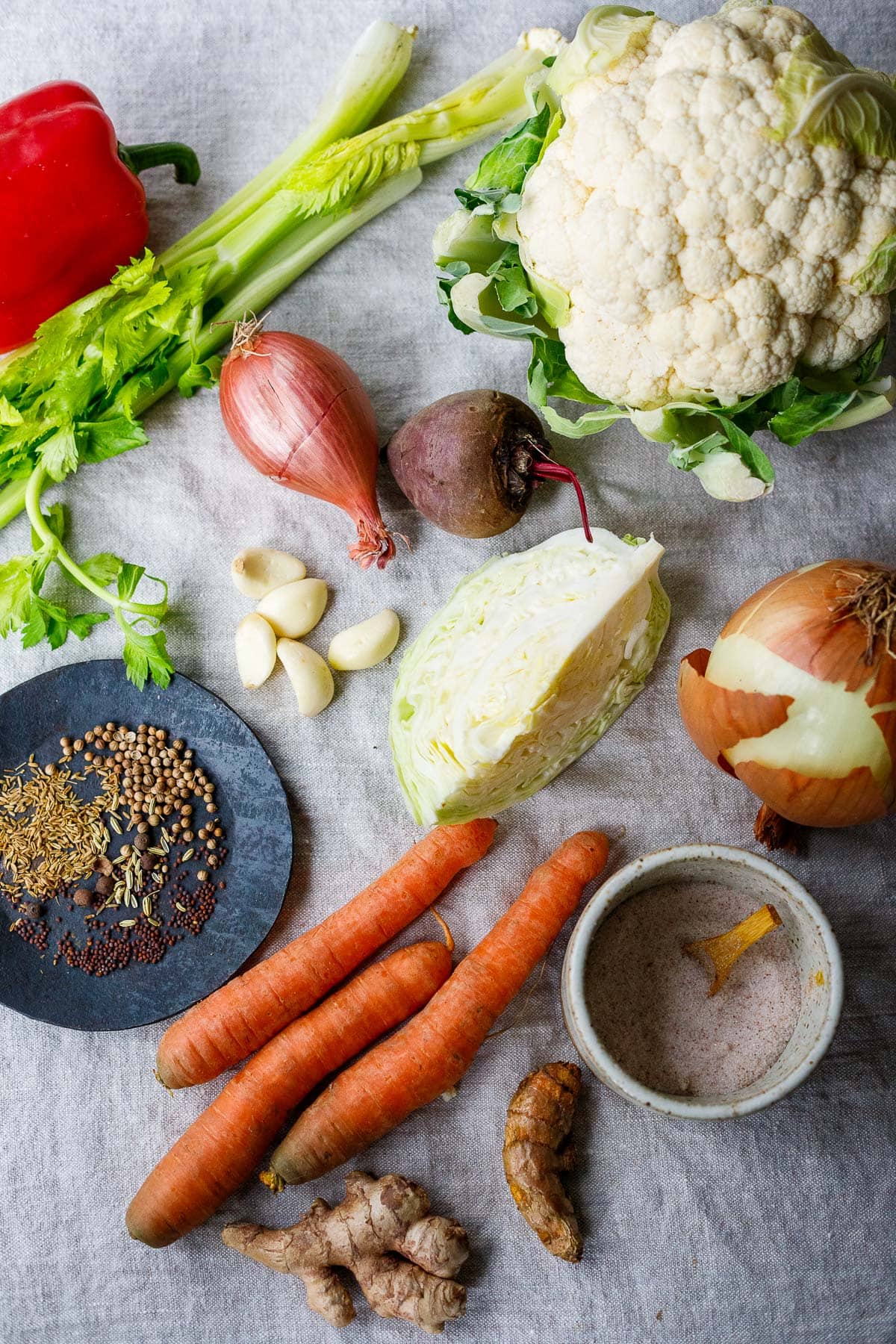
- Organic vegetables: Choose 2-3 veggies, such as celery, carrots, fennel, bell pepper, red beets, or cabbage. Wash the veggies, but do not peel them.
- Whole spices: Fennel seeds, cumin seeds, coriander seeds, mustard seeds, dill seeds, anise seeds, allspice, black peppercorns, star anise
- Onion: Use sliced onion or sub with leeks or shallot.
- Garlic cloves: Peel and slice them in half.
- Cabbage leaves: just a couple to hold things down in the jar.
- Optional additions: Sliced turmeric root and (or) sliced ginger root (⅛-¼ cup total).
- Fine sea salt: Or use Himalayan pink salt.
- Filtered water: Tap water can contain chlorine, which can prohibit fermentation.
- Equipment: 8-cup mason jar, lid, and fermentation weight (or something clean that can be used as a weight that fits inside the jar, like a small shot glass)
How to make Fermented Gut Shot
Place whole spices in the bottom of a clean, 8-cup jar. Add onion, garlic, and optional turmeric root and ginger root. Add the organic veggies, slicing thinly, filling up roughly half the jar.
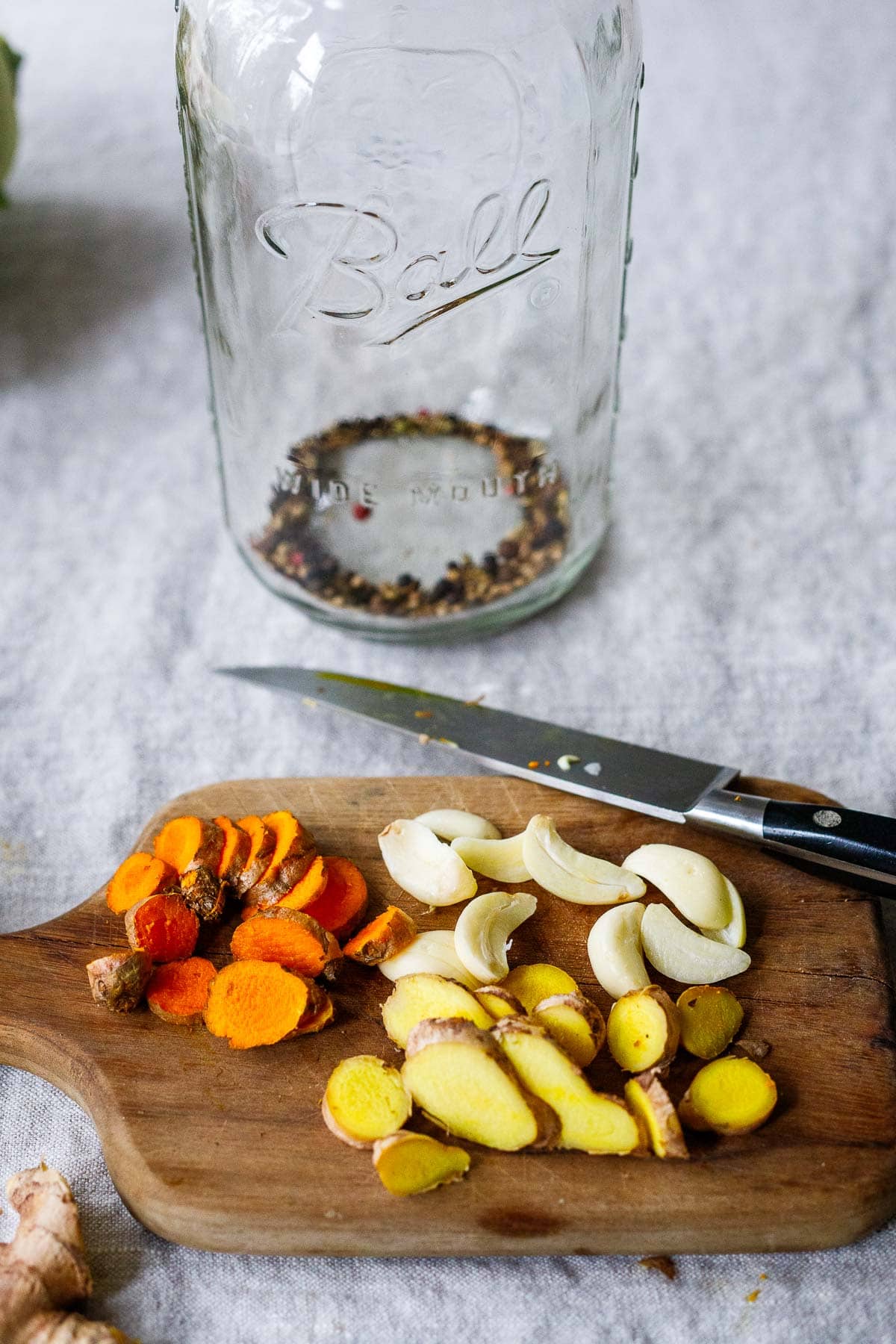
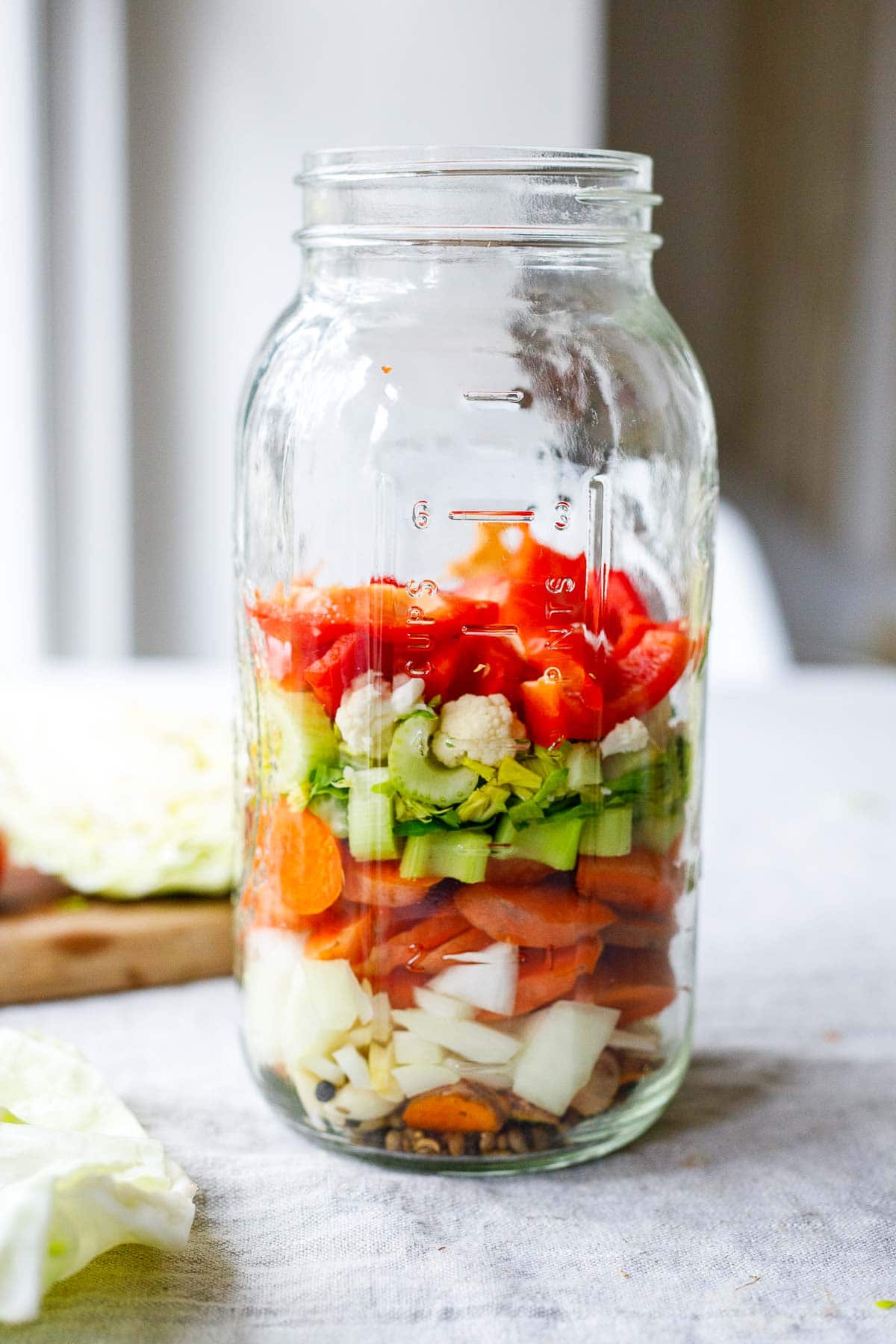
Cover with a few cabbage leaves (which will keep everything under the brine) and press down.
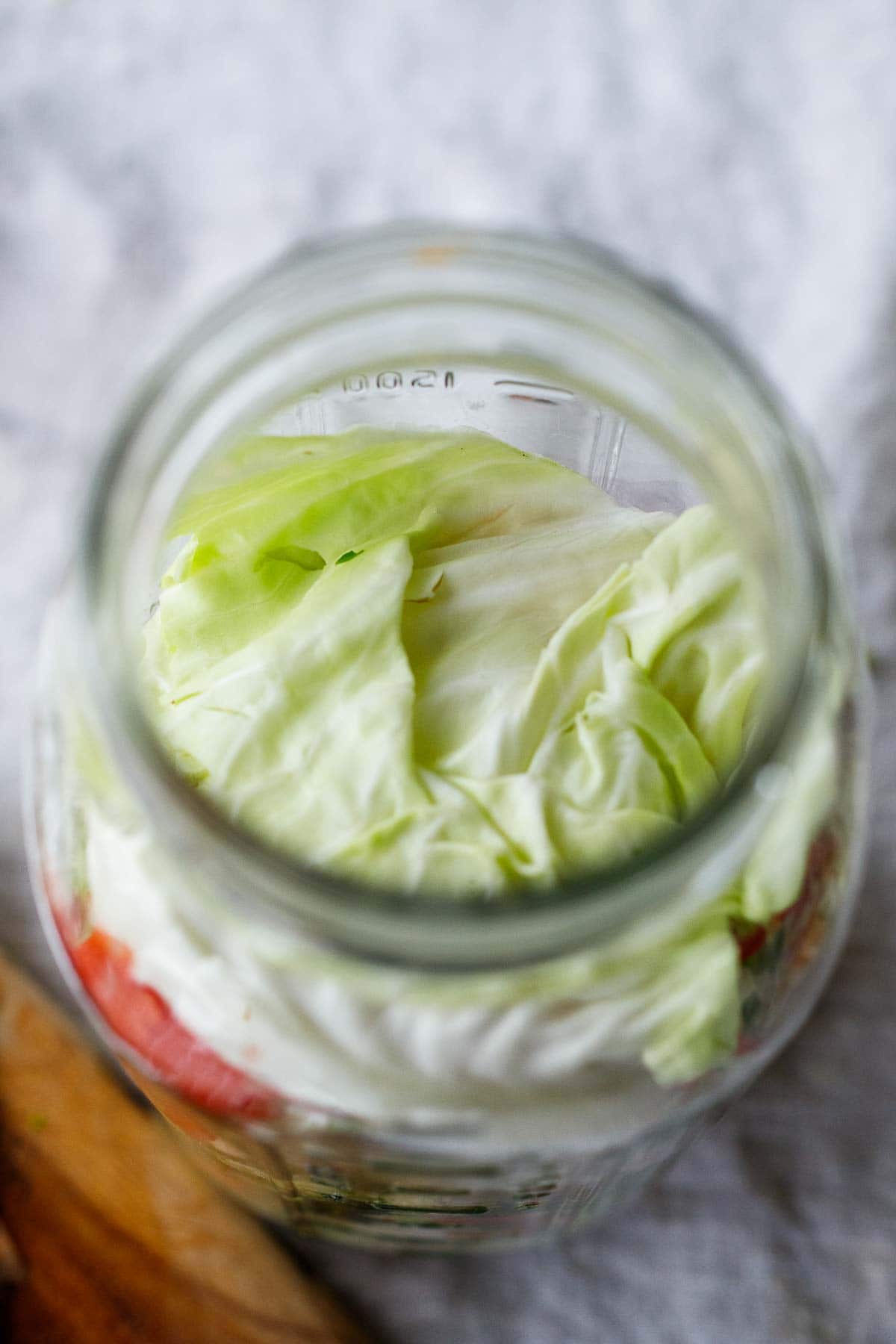
Weigh down the cabbage leaves using a fermentation weight or something small and clean that fits into the jar like a shot glass.
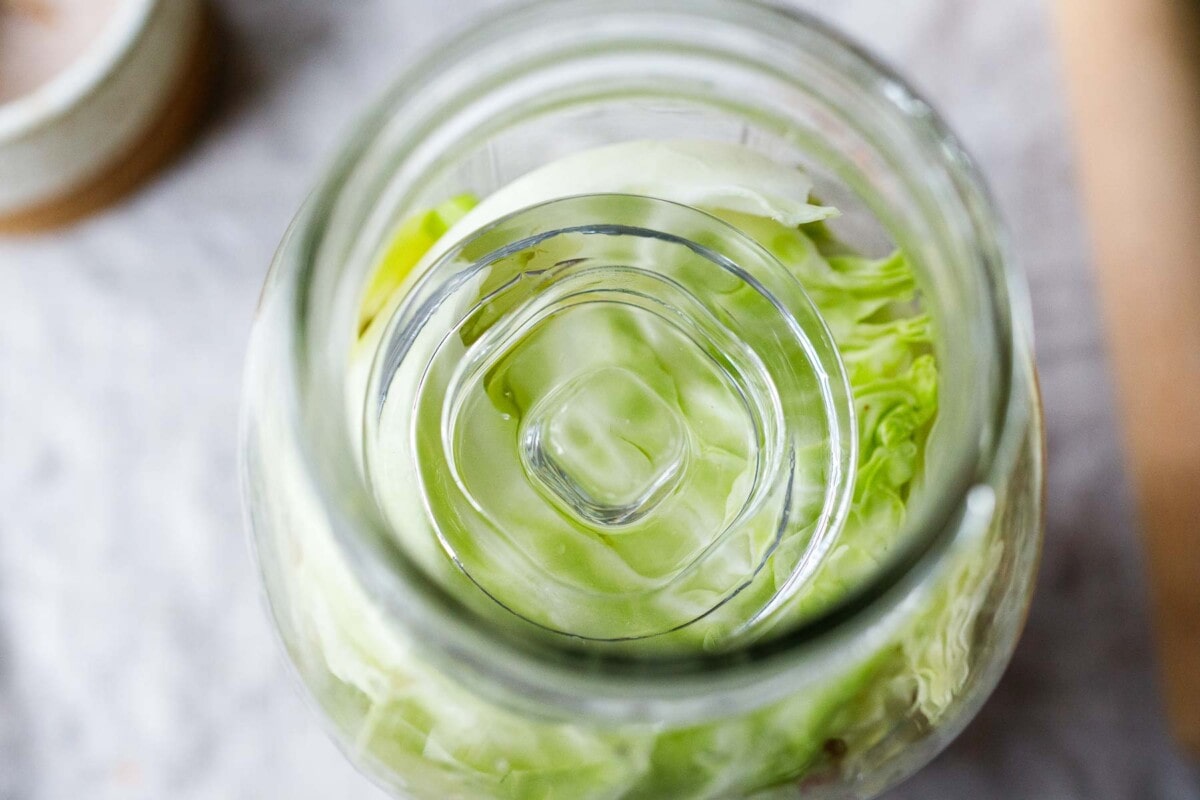
Make the salt water brine using a 3% solution. Mix 4 cups filtered water with 1 ½ tablespoons fine sea salt and stir until salt dissolves. Pour this over the weighted cabbage leaves.
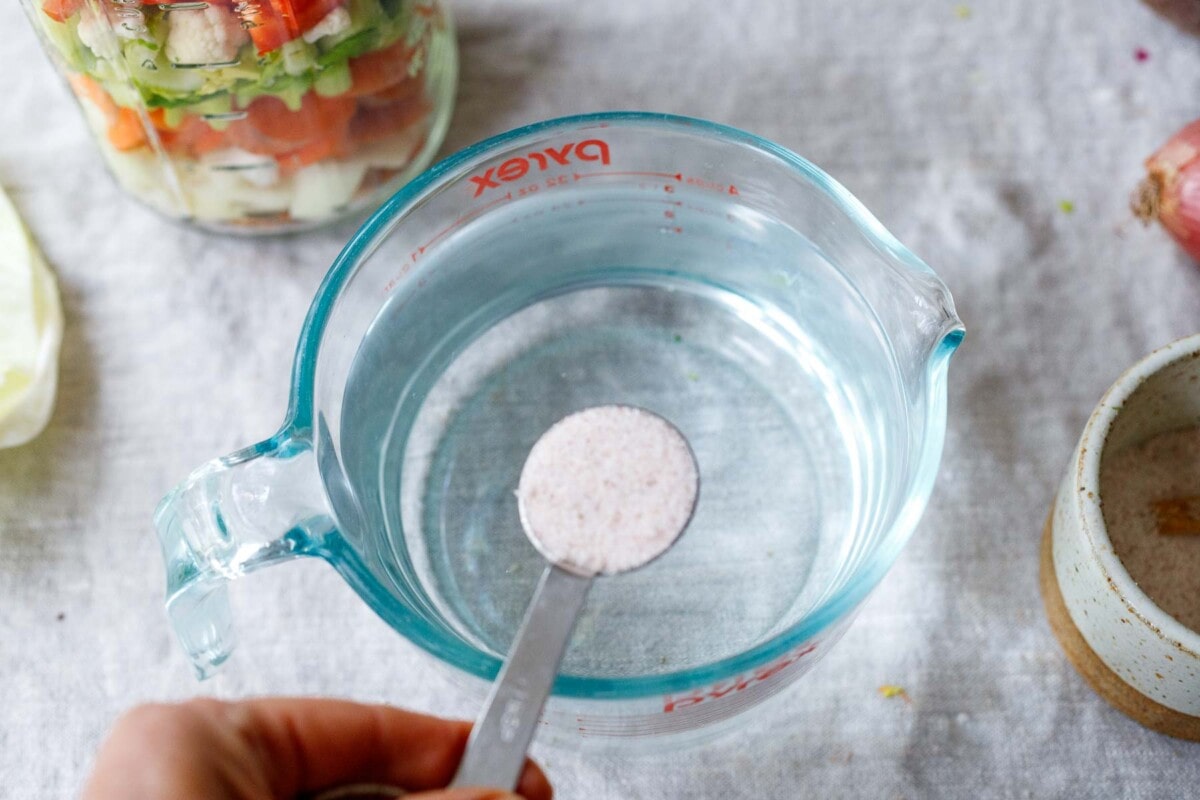
Fill the jar, leaving 1 1/2 inches of headroom. If you need more brine to fill the jar, use a mixture of 1 cup water with 1 heaping teaspoon salt.
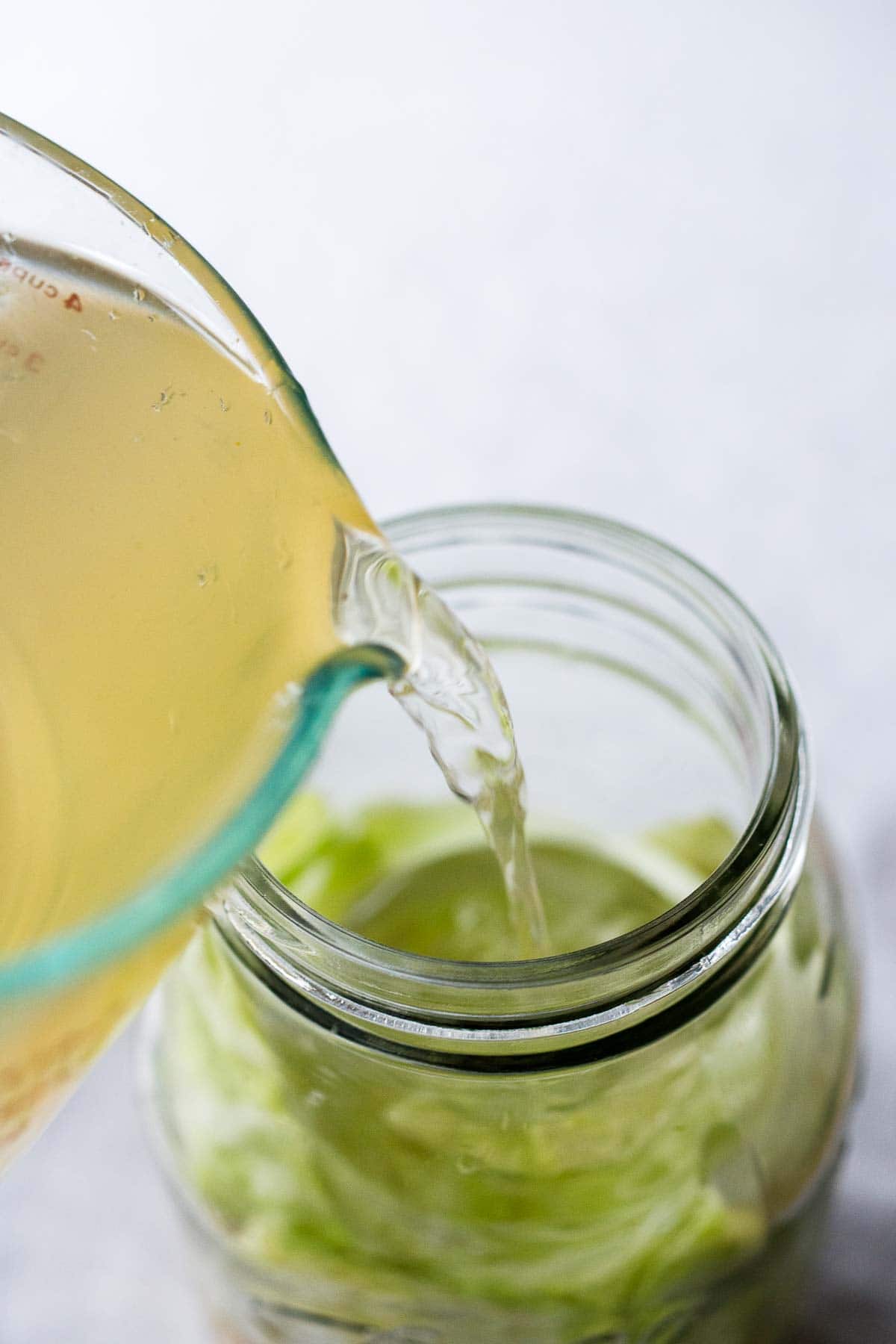
If any seeds or scraps float to the top, remove them with a slotted spoon. Any debris that floats to the surface may cause mold, so everything needs to be submerged under the brine. (You can check for this daily during the fermentation period.)
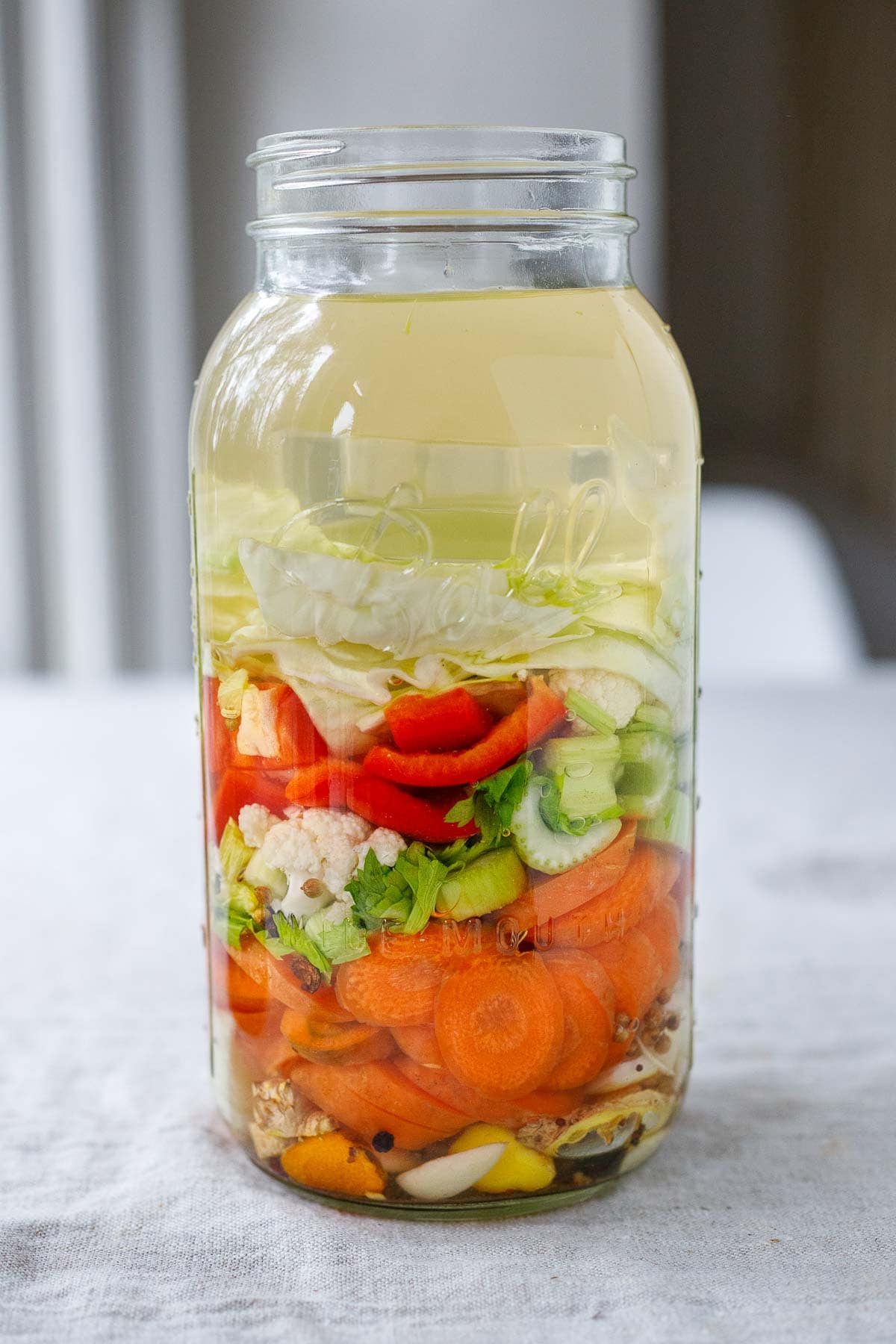
Cover, but do not tighten the lid, and place the jar over a plate to catch any overflow. You want the bubbles from the fermentation to be able to escape.
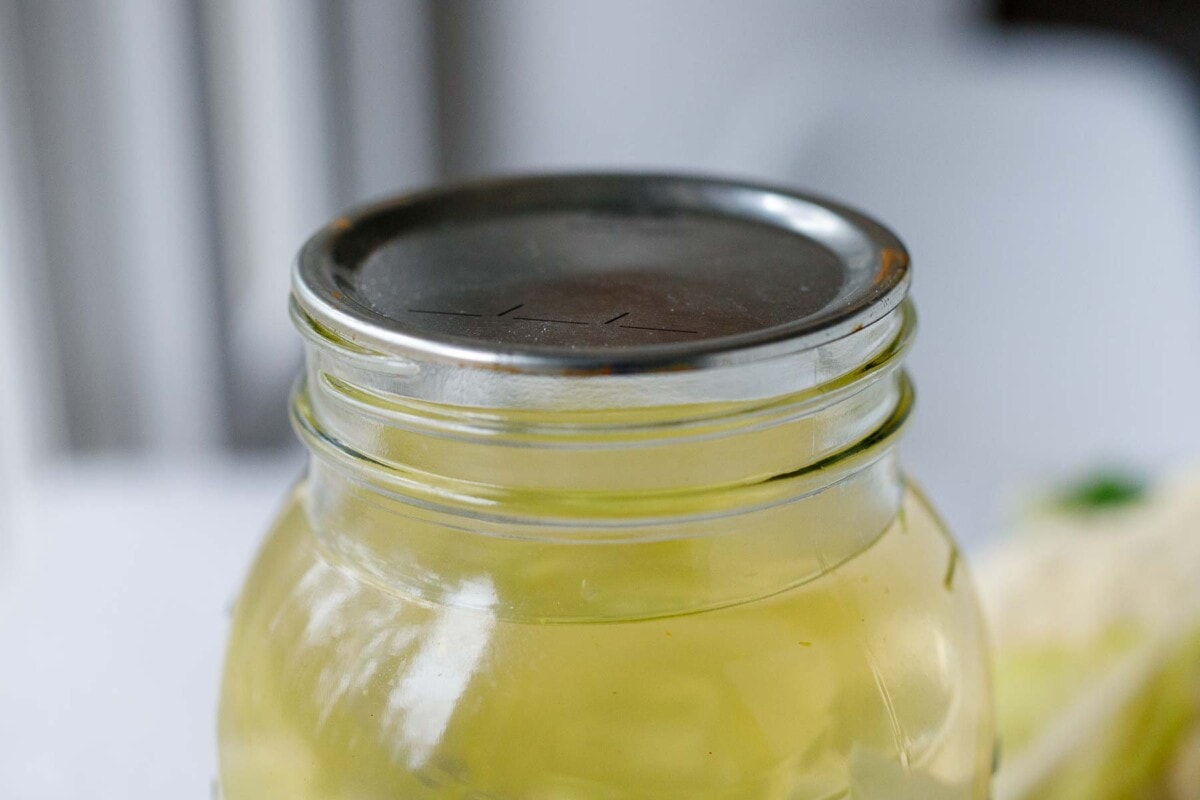
You can also use an airlock system like shown below, but know that a simple lid will suffice.
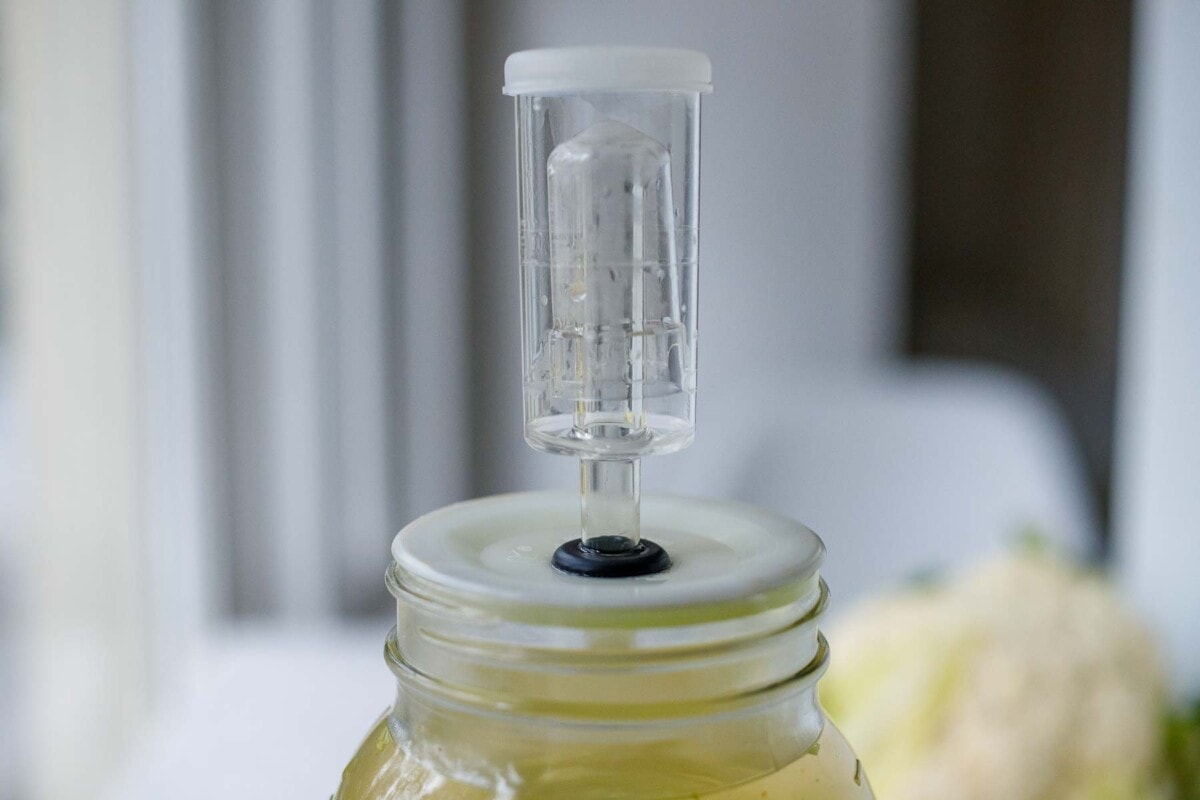
Place the jar in a cool place; 65F-70F is ideal. (In winter, I leave it on my kitchen counter and check daily for any seeds that may have escaped and floated to the surface. In summer, placing the jar in a cool basement or lower cupboard is ideal.)
Let this ferment for 3-4 days, then taste. The longer you ferment, the more tangy it will become. As the healthy bacteria “eat” the sugars or lactose from the veggies, they create acidity; also known as lacto-fermentation.
Lacto-fermentation is a two-step process: in the first step, the salt inhibits the bad bacteria, allowing the good bacteria to grow, flourish and have more space. Once the good guys grow, they feed on the sugars in the veggies and produce the acidity as a byproduct. This is the second stage or step. The tangy flavor indicates it has indeed reached the second step and is fermenting.
I like to leave this five days for optimum flavor. You may notice bubbles as you tap the jar. Or a slight cloudiness. Both are good signs. The jar should smell like pickle juice- clean and briny. Once satisfied with the smell and flavor, place the fermented brine in the fridge, lightly covered.
It will continue to ferment in the refrigerator but more slowly and will keep indefinitely.
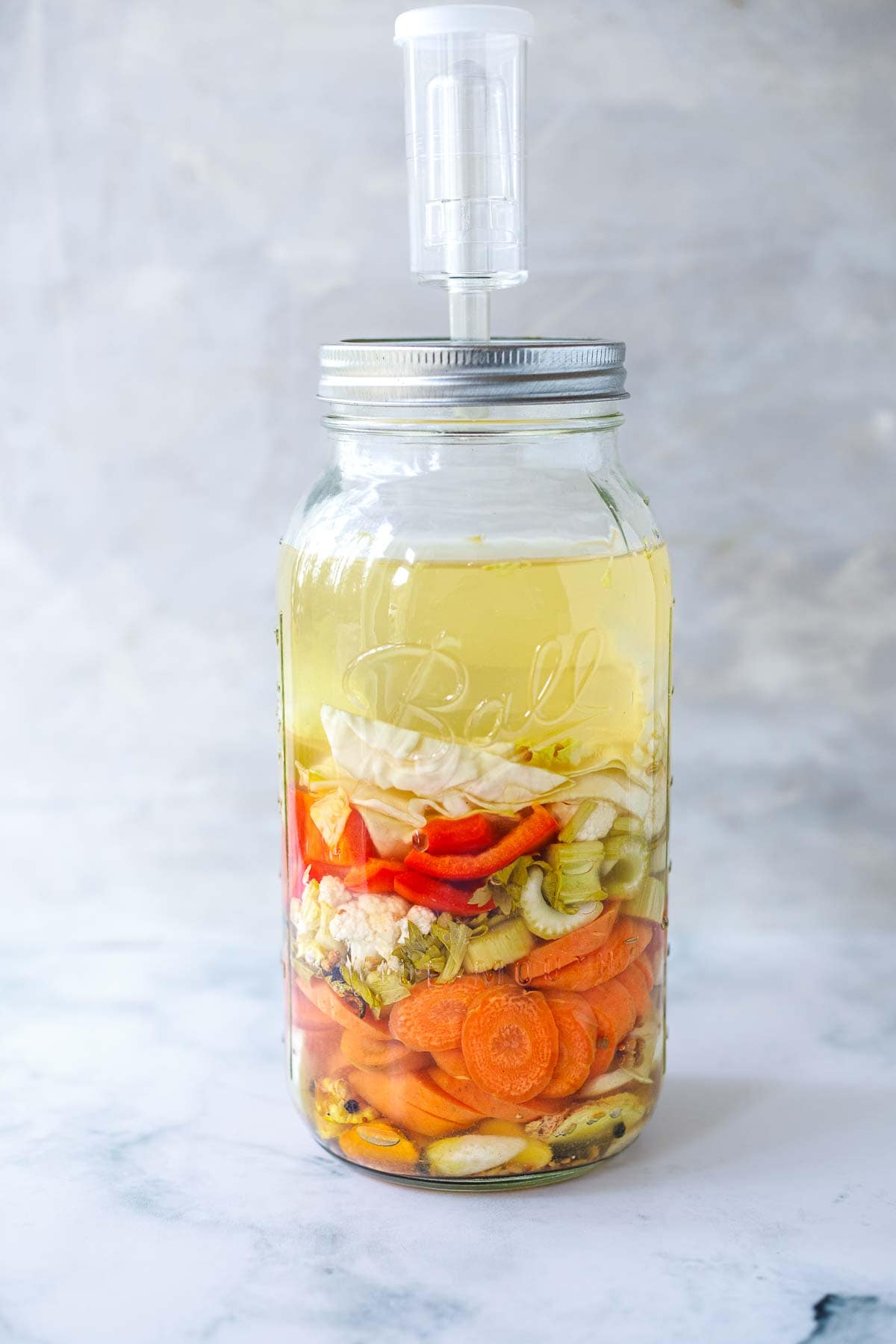
Serving and Storage
For optimal microbiome health, drink a 2-ounce gut shot every day (just strain it out of the jar). Consider this your daily dose of digestive strength! It is a positive habit to add to your daily routine.
TIP: If you are new to probiotics, start with one teaspoon or one tablespoon per meal per day. You can gradually work up from there.
You can also take a shot before each meal. They can give you a boost for the day when taken in the morning, or you can take it after a meal to stimulate digestion. We think the flavor is delicious, but if it’s too tangy or savory for you, try diluting it a bit with water.
The veggies are edible and are full of probiotics too!
In order to keep the cultures alive and active, store in the refrigerator in a sealed jar.
Gut shot FAQs
Store-bought gut shots are usually made with sugar and juices, but this homemade gut shot is savory, made with fermented organic vegetables (creating a vegetable juice), sea salt, whole spices, and filtered water.
Yes! Taking a gut shot every day is similar to taking a probiotic or consuming yogurt for microbiome health. The veggie drink contains active probiotic cultures, giving your body an effective probiotic boost.
You can take a gut shot three times a day, with each meal, or you can take one every morning. Overall a few shots a day is ideal to stay healthy!
Yes, or homegrown or from your local farmers market. You do not want to ferment anything that has been treated with herbicides or glyphosates.
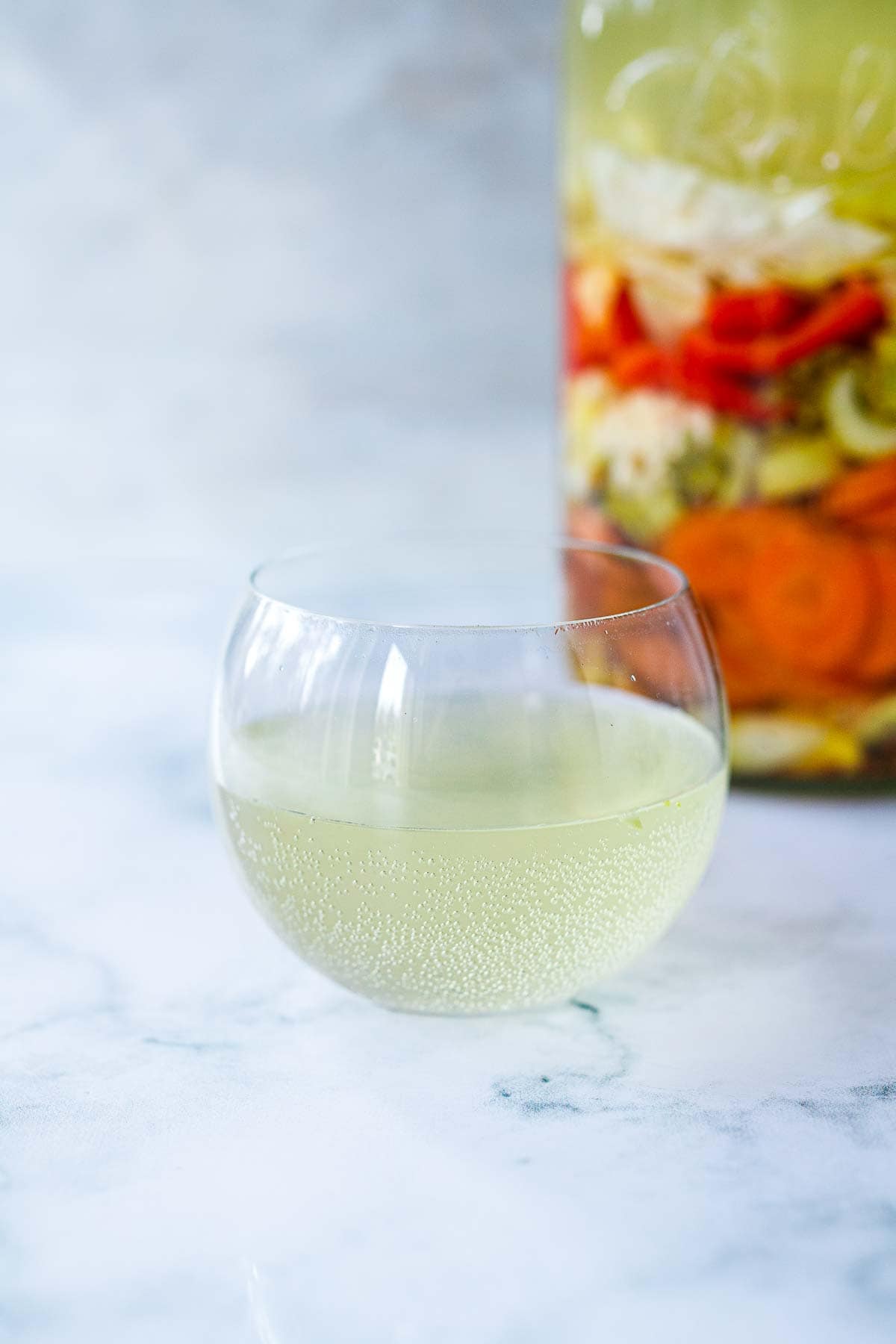
Probiotic Benefits
There are so many reasons to consume fermented foods and probiotics daily, like this gut shot that contains strains of live probiotic cultures. Here are the benefits of consuming live active cultures:
- Improved Digestion: Probiotics can help maintain a healthy balance of gut bacteria, preventing dysbiosis or leaky gut. Probiotics aid in digestion and nutrient absorption. Read more.
- Enhanced Immunity: A healthy gut contributes to a strong immune system, and probiotics can help support this by promoting a balanced gut microbiome. Further information.
- Mental Health Support: Some studies suggest that probiotics may have a positive impact on mental health, potentially helping to reduce symptoms of anxiety and depression. Explore the study.
- Reduced Inflammation: Certain probiotic strains have been linked to a reduction in inflammation in the body, which may benefit overall health. Read this.
- Metabolic Health. Adding fermented foods to the diet can play a role in preventing and managing metabolic conditions, such as obesity and diabetes. The metabolites produced during fermentation can help regulate appetite and improve insulin sensitivity. Some fermented foods have been associated with better weight management. Delve into the details.
- Cardiovascular Health. The bioactive peptides produced during the fermentation process have been recognized for their role in cardiovascular health. These substances can lower blood pressure and have anti-thrombotic properties, which are important in the prevention of heart disease. Check out the research.
We hope you enjoy this tangy shot and your new digestive glow!
Love this recipe? Please let us know in the comments and leave a 5-star ⭐️⭐️⭐️⭐️⭐️ rating below the recipe card.
More Fermented Probiotic Recipes!
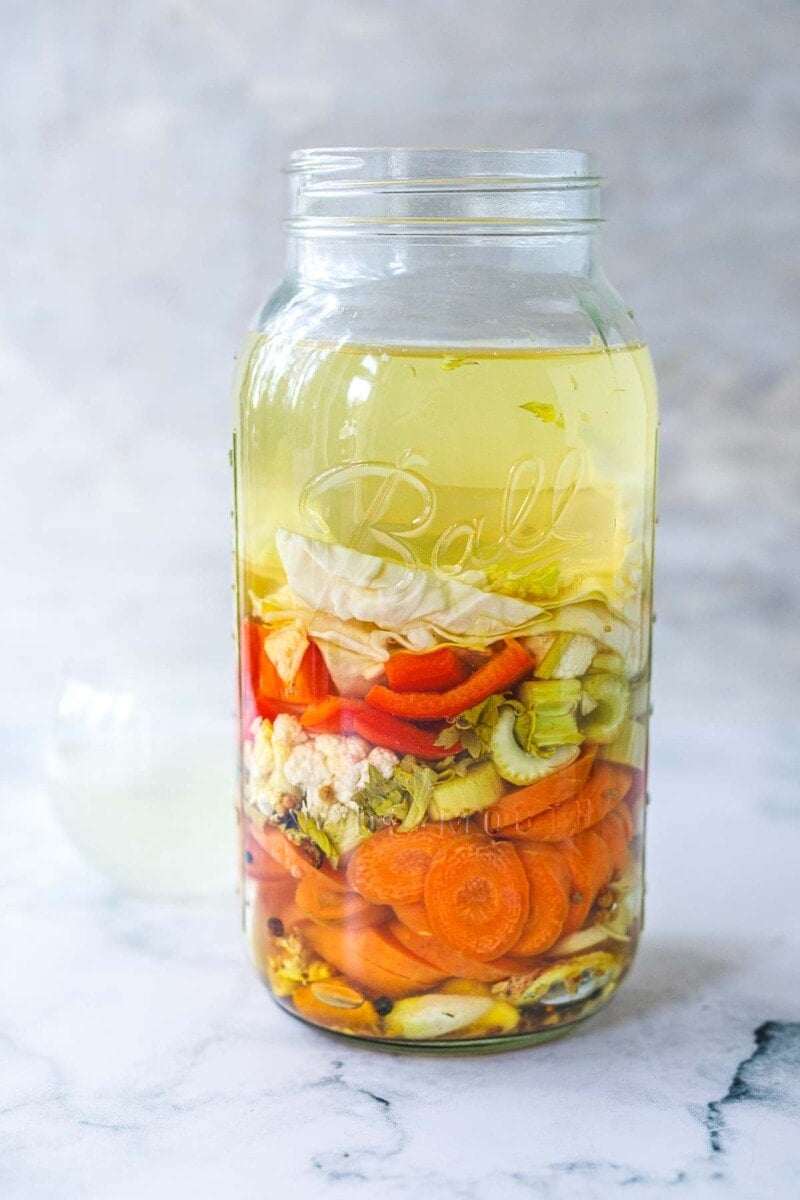
Gut Shot Recipe (Video)
- Prep Time: 15
- Cook Time: 5 days
- Total Time: 120 hours 15 minutes
- Yield: 8 cups 1x
- Category: drinks, probiotic, fermentation
- Method: fermented
- Cuisine: American
- Diet: Vegan
Description
Rich in probiotics, the Gut Shot is a fermented vegetable drink that supports gut health by creating diversity in the gut microbiome-an easy step-by-step guide using veggies you already have with just 15 minutes of hands-on time.
Ingredients
- 2 tablespoons whole spices: fennel seeds, cumin seeds, coriander seeds, mustard seeds, dill seeds, anise seeds, allspice, black peppercorns, star anise.
- 1/2–1 onion, sliced (or sub leeks or shallot)
- 10–20 garlic cloves, sliced in half
- Optional additions: sliced turmeric root and or sliced ginger root (1/8-1/4 cup total)
- Organic Vegetables (choose 2-3) celery, carrots, fennel, bell pepper, beets, cabbage, etc. sliced or chopped small. (about 3-4 cups). Wash the veggies, but do not peel.
- 2 cabbage leaves
- Fine Sea salt or Himalayan pink salt
- Filtered Water (tap water can contain chlorine, which can prohibit fermentation)
Instructions
- Place whole spices in the bottom of a clean, 8-cup jar.
- Add onion, garlic, and optional turmeric root and ginger root.
- Add vegetables, slicing thinly, filling up roughly half the jar.
- Cover with cabbage leaves (which will keep everything under the brine)
- Weight down the cabbage leaves using a fermentation weight or something small and clean that fits into the jar like a shot glass. Press down a little.
- Make the brine using a 3% solution. Mix 4 cups filtered water with 1 ½ tablespoons sea salt. Pour this over the weighted cabbage leaves. Fill the jar, leaving 1 1/2 inches of headroom. If you need more brine to fill the jar, use 1 cup water with 1 teaspoon salt.
- If any seeds or scraps float to the top, remove them with a slotted spoon. Any debris that floats to the surface may cause mold, so everything needs to be submerged under the brine. ( You can check for this daily during the fermentation period.)
- Cover, but do not tighten the lid, and place over a plate to catch any overflow. You want the bubbles from the fermentation to be able to escape. You can also use an airlock system (see photos above).
- Place it in a cool place; 65F-70F is ideal. ( In winter, I leave it on my kitchen counter and check daily for any seeds that may have escaped and floated to the surface. In summer, placing the jar in a cool basement or lower cupboard is ideal. )
- Let this ferment for 3 days, then taste. The longer you ferment, the more tangy it will become. I like to leave this 5 days for optimum flavor. Place in the fridge, lightly covered. It will continue to ferment in the refrigerator but more slowly and will keep indefinitely.
- Drink a 2-ounce glass full of gut shot each day or with each meal. And Yes, the vegetables are edible and delicious!
Notes
If you are new to consuming probiotics, start gently, consuming one teaspoon or tablespoon, per meal, gradually adding more as tolerated.
This must be refrigerated and can not be canned, or frozen in order to keep the cultures alive and active.
Nutrition
- Serving Size: 2 ounces
- Calories: 12
- Sugar: 0.8 g
- Sodium: 767.7 mg
- Fat: 0.1 g
- Saturated Fat: 0 g
- Carbohydrates: 2.5 g
- Fiber: 0.7 g
- Protein: 0.5 g
- Cholesterol: 0 mg
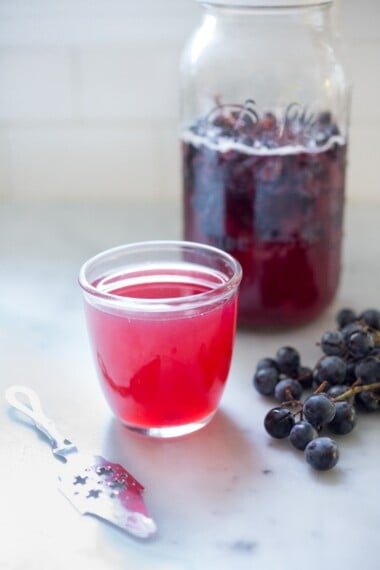
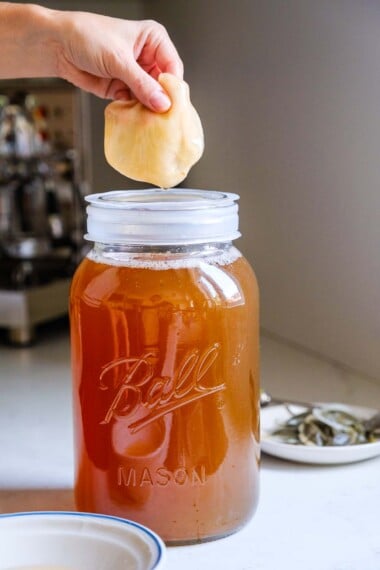
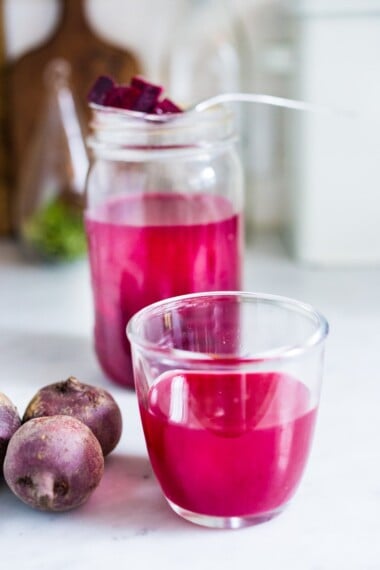
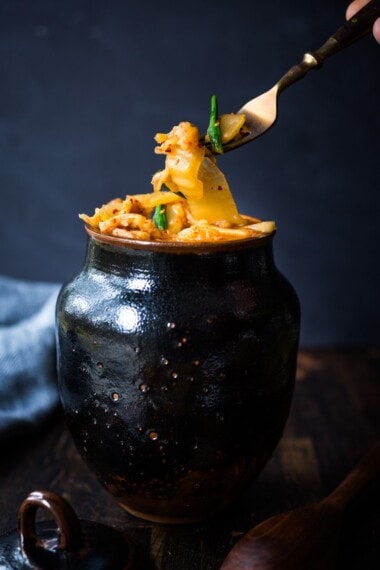
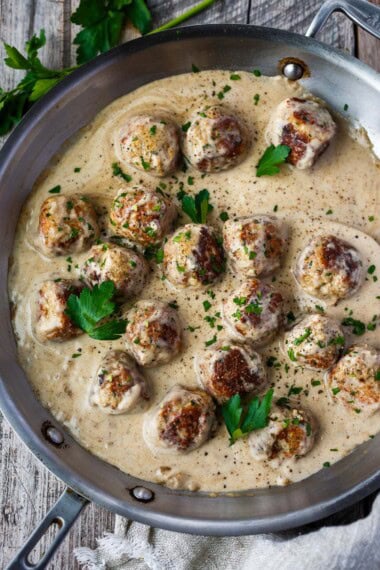

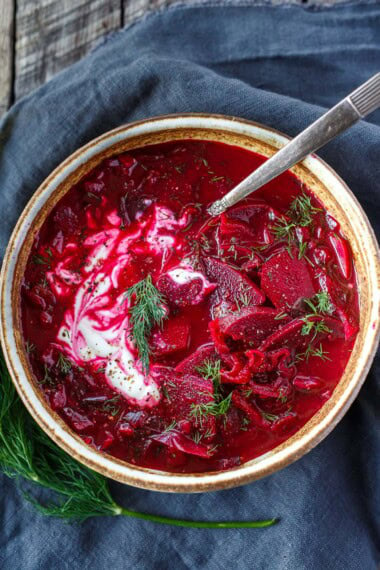


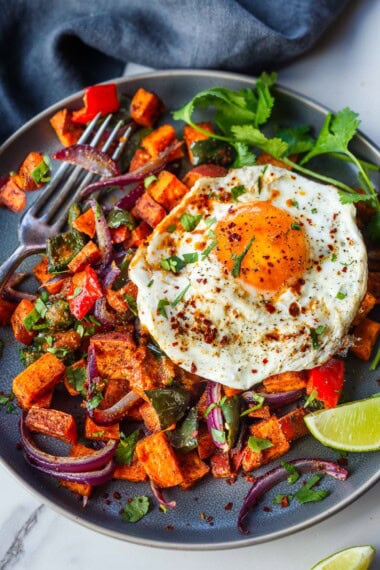

Thank you. Very simple. So simple it finally got me started on the fermentation path – now I’m hooked. 🙂
Awesome Martin, it is a healthy addiction.😉
How long does this keep in the fridge
Indefinitely!
It seems to have lost its light fizz though…Been in the fridge for a week , as I continue to top up with salted water
I would not top with salted water- you will dilute the fermentation, just drink it and make it again. 🙂 You can save a few tablespoons for you next batch!
Wonderful!
Awesome!
The recipe seems tobe beneficial
items of health but I am scared of fermentation because I have peptic ulcers.
You have explained it nicely, 5 ⭐ for you.
Thanks Lebo- and yes, I am not sure how fermented foods affect peptic ulcers. I would contact your healthy care provider.
You have any data to back this up? Id like to see it
I will link it in the post body: or you can copy and paste this into your bowser: https://med.stanford.edu/news/all-news/2021/07/fermented-food-diet-increases-microbiome-diversity-lowers-inflammation
I have been waiting for this fermentation process, cool
Awesome, thanks Linah!
I would like to make this and wondered if I could use the dried juniper berries that I have. I bought them for a recipe and now don’t know what to do with the rest. I’m not sure at all how these berries are used. Thank you! I love your recipes by the way
Yes, absolultey! They would be lovely here.
Great!
Wonderful
Also, can you use pickle juice for the brine??
Hey John,I am not sure I understanding what you mean? The idea here is making the probiotic brine, otherwise just drink the pickle juice if it is fermented? If you are making your own fermented pickles or have fermented pickle brine that you want to use up, you could add a couple tablespoons of that brine to this brine to jump start it if you like? But do not add a vinegar-based pickle juice, that kinda just defeats the purpose. 🙂
Can you reuse the veggies to make another batch??
Hi Jon, I actually don’t know the answer to this, I don’t reuse them, we eat them. 🙂
Love it
It is 1 TBS off each of those spices, or a total of 1 TBS of that spice combo
Hi Susan, a total of 2 tablespoons of spices, any combination.
I am confused. I have made fermented tomato salsa and the recipe instructed me to pour water/ salt solution over the vegetables and then put weight on top of the whole thing. Why do you put the water/salt solution over the weight in gut shots?
The focus is more on the brine here, so there is more liquid than veggies. The weight is to keep them from floating up, we want them submerged in the brine. 🙂
I see what you mean but I am still under the impression that it is the salt brine that actually causes the veggies to ferment. This is the case with kimchi and sauerkraut, anyway.
Sorry maybe I am not understanding your question? Yes, it is the same principle as many of the other ferments on the blog, there is just more liquid (salt brine) to veggie ratio. The veggies do get fermented in the brine, we are just keeping them weighted down lower in the jar.
What I mean is that the veggies should actually be IN the salt brine then
cabbage leaf and weight.
The way it is described in recipe seems like veggies are underneath salt brine. That is to say separated from brine because cabbage leaf and weight are placed on top of dry, unsalted veggies. Does that make sense 🤔.
Hi Marie, yes, the veggies are absolutely in the brine! Not separated. The leaves just prevent little scraps and spices from floating up. 🙂 Brine fills the entire jar.
Just what i was looking for
Wonderful!
Love it!
Do you start from scratch once you use what you put in the fridge or do you continue to add more water/salt mixture to the same mason jar and veggies?
I start from scratch, but I’ll often add a couple tablespoons of the old brine to new mixture.
Makes sense! Thanks so much. Looking forward to trying this.
Is it 2tbsp of each spice or a total of 2 tbsp. Can you add more of one if you don’t have everything?
2 tablespoons total of your choice of spices.
Do we use a total of 2 tablespoons of a mixture of the spices, or 2 tablespoons of each spice?
Thank you!
I used 2 tablespoons total!
Does the Gut Shot get its microbes from the air and from whatever is on the veggies?
Yes probably both, but mainly veggies. The process is called Lacto fermentation. The salt water inhibits the growth of bad bacteria, and gives the good bacteria room to grow. Once they begin growing, the Lactobacillus organisms begin converting (eating) the lactose (or sugars) in the veggies into lactic acid, giving it that tangy flavor. In sourdough, they come from both, the wild yeast in the air and bacteria in the flour. At least this is how I understand it? 🙂
Hi Sylvia, After 5 days, how long will this keep in the refrigerator? I’m definitely going to make this!
It keeps indefinately. 🙂
Can’t wait to try this. What’s the glass in the last pic, btw? Looks great!
Thanks Manu- what is in the glass? or what is the actual glass brand? I am not sure of the brand, they were a gift!
Hi Sylvia
Looking forward to trying this out. Can a fresh brine be added to the veggies to make a 2nd or 3rd batch? Thanks.
Dave
Hi Dave- that is a great question, and honestly I am not sure. We usually just eat the veggies. I’ll use some of the old brine to make a new batch -adding a couple tablespoons of old brine to the the new brine with new veggies.
Please send more self-made healthy recipes like this. On the whole spices: is better to choose one kind or a few, I’m off to get ingredients. I’ve been waiting for this and didn’t know. Thanks!
I like using several spices here to add nice flavor.
Hi Sylvia,
After fermenting and you’re measuring out a shot, do you just strain some out of the jar? Wasn’t sure from your instructions. Thanks.
Janice
Yes, Janice sorry, I just pour some out, or stick a clean measuring cup into the jar ( ¼ cup) and scoop some out. You can strain if you like. It is more than ok to eat the veggies too.
Wonderful, thanks!
Thanks Janice!
Do the veggies have to be organic? What about if I can’t get organic? Thank you!
I highly recommend it. Conventional veggies, often contain glyphosates (herbicides), which damage the gut microbiome. I am not sure they can be “washed off” I believe it is systemic. Kind of counter-productive? Just my opinion and I may be wrong here…